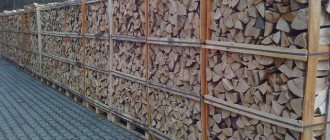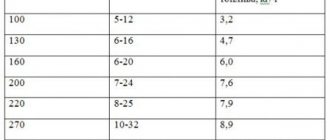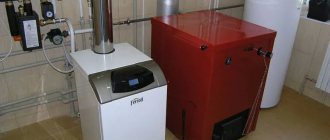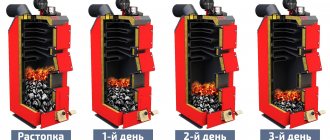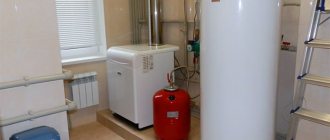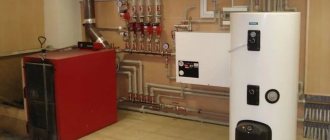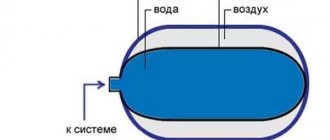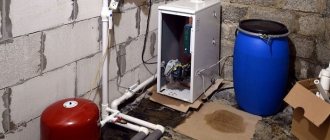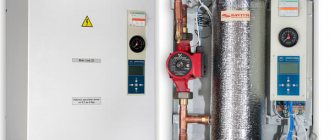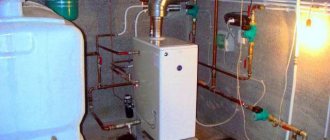Boiler DEFRO DUO, 25 kW
Technical and economic performance indicators of the DEFRO boiler by month of the heating period:
| Unit change | ||
| Heated area: | 200 | sq.m |
| Ceiling height: | 3,0 | m |
| Room temperature: | 22 | o C |
| Price of packaged coal: | 3,6 | rub./kg |
| Calorific value of coal: | 5,8 | kW*kg |
| DEFRO boiler efficiency: | 90 | % |
| Specific thermal characteristics of the building: | 0,41 |
Meaning
| Unit change | ||
| Fuel consumption for the heating season, t: | 8,32 | T. |
| Coal costs per season, rub.: | 29,935 | rub. |
| Average monthly coal costs, rub.: | 3,326 | rub. |
| Average boiler operating time on one fuel load, days: | 8,7 | days |
Calculation for the coldest day:
| Options: | Meaning | Unit change |
| Temperature of the coldest day of the year: | -39 | °C |
| Maximum heat consumption: | 15,84 | kWh |
| Maximum fuel consumption, kg/hour: | 3,00 | kg/hour |
| Approximate boiler power, kW: | 20 | kW |
As you can see, the estimated coal consumption will be 8.3 tons per season, and the average boiler operating time with 1 load of fuel is about 8.7 days. For climate zones 1 and 2, coal consumption will be noticeably lower; for climate zone 4, consumption will increase.
How to calculate coal consumption in a boiler for the heating season
How quickly is coal consumed in a solid fuel boiler? How much should you stock up on before the heating season so that the temperature in the house always remains comfortable? These and many similar questions are asked, perhaps, by every homeowner whose home is equipped with an individual heating system.
Let's try to figure out how to correctly calculate the coal consumption in the boiler, and what parameters need to be taken into account in order for the results to be accurate.
Why is it beneficial to use coal?
The operation of modern solid fuel boilers does not cause any trouble. Especially if the homeowner prefers coal - an efficient, safe, convenient and cost-effective fuel. Compared to other types of the latter, it has many advantages:
- is characterized by high heat transfer, allowing to obtain much more heat per unit of heated area;
- not afraid of humidity;
- does not require special sealed containers for storage;
- It is sold in a convenient package in which it can be easily transported to a city home or to the country.
Installing a coal boiler allows you to not depend on the presence of a gas pipeline within reach, which is especially important for residents of the private sector. In addition, this type of heating equipment can be installed without special permission, which cannot be done, for example, by purchasing a gas boiler.
An additional benefit of using coal as a fuel is provided by the special design of modern boilers. Over the years, not only the appearance of the equipment has improved, but also the method of burning fuel, and, accordingly, its consumption.
Firstly, there was no longer a need to pour coal into the firebox several times a day and clean out the slag. Modern boilers have large combustion chambers and special safe bunkers for storing fuel, from which it is automatically supplied to the firebox via a conveyor as needed. You can immediately load as much coal into the chamber as is necessary for continuous operation of the system for 10-12 hours, and the volume of the bunker is designed for 6-7 days of constant burning of the boiler.
The combustion chambers in modern models of heating equipment are completely sealed and equipped with special ventilation systems, thanks to which the strength of coal combustion and the degree of heating of the system are adjusted. Due to the forced supply of the optimal volume of air, the fuel burns out almost completely, leaving behind a minimal amount of waste, which allows to significantly reduce its consumption.
Fireplaces and fireplace inserts cost savings, highest quality and convenient purchase
Fireplaces and fireplace inserts for heating – features of selection and application:
When choosing a fireplace, you should understand that it is primarily a heating device. That is why its acquisition should be taken with the utmost seriousness.
It is important to consider the technical capabilities, purpose and design features of the models you choose. You also need to remember that fireplace inserts from different manufacturers differ significantly from each other in precisely these indicators. Despite this, externally, fireplace inserts can be very similar.
Despite this, externally, fireplace inserts can be very similar.
How to reduce home heating costs?
Fireplace inserts can perform the function of heating equipment: be both the main and auxiliary source of heating in the house. But not every fireplace insert can heat a house. Fireplace inserts can be either for decorative purposes (with intermittent combustion) or with a heating function (continuous combustion).
Two types of functional fireplace inserts will help you save on heating your home:
- – with air heating;
- – with water heating.
To heat a water heating system, you need to buy a fireplace with a water circuit. It will perform the work of a solid fuel boiler and fireplace at the same time. Most often, a water fireplace is used in a system with another heat source, for example, a gas or electric boiler. When the fireplace is operating, the other source is automatically switched off. A fireplace with a water circuit can also independently heat the entire house. This saves money on heating your home.
The efficiency of a fireplace-based air heating system depends on many factors:
If it is not possible to install a traditional wood-burning fireplace, and the dream of home comfort with a fireplace does not leave you, we suggest buying an electric fireplace with a 3D flame effect. For country houses or cold rooms, free-standing fireplaces and stoves that do not need finishing are ideal. We can also offer you stoves for baths and saunas.
To purchase a fireplace and order its installation:
You can send us a house plan by email, or order a visit from our specialist to take measurements on site. We will make you a free commercial offer for a fireplace heating system, which will indicate all the necessary equipment.
A good fireplace can really heat up your home quickly. You won't turn your beautiful living room into a boiler room, since you won't have to add wood to the fireplace every hour. Our fireplace inserts allow one load of wood to burn for a long time, even up to 12 hours.
You can buy fireplaces, fireplace inserts in Ukraine or other products presented by us by ordering them by phone or through an online store. In all cities of Ukraine we deliver by transport service.
What factors need to be considered
When determining the consumption of coal in a boiler for heating a house, the most difficult thing is to select accurate initial data for performing the calculation. The volume of solid fuel required to heat a room depends on many parameters. First of all, you need to take into account the quality of the raw material: brown coal has the lowest heat transfer rates, and anthracite coal has the highest. You also need to consider:
- specifics of the heating system model;
- climate features (average daily temperatures in the cold season, duration of the winter period, etc.);
- materials that were used to build the house;
- the number of windows and doors, as well as what they are made of (wood or PVC);
- age and size of the house (number and area of rooms, ceiling height, number of floors, etc.);
- quality of thermal insulation materials;
- stoker's experience and skills.
At the same time, the listed factors must be considered as a whole. For example, when using the same boiler model, fuel consumption for heating a stone house after a major renovation and a country cottage without high-quality thermal insulation of the walls will differ dramatically.
It is almost impossible to take into account all variables when calculating, therefore, regardless of the type of fuel, only the average value of its consumption during the cold season is determined.
Regardless of the type of fuel, when calculating consumption, only the average value of its consumption during the cold season is determined.
Which coal is better
All types of coal suitable for use in heating systems have different characteristics and, most importantly, different heat transfer rates. It is also important to remember this when calculating the amount of solid fuel required to heat a room in the cold season.
In addition, the volume of by-products formed during combustion also depends on the type of coal. For example, varieties such as long-flame and gas coal emit large amounts of furnace gas and smoke when burned. This causes additional troubles for boiler owners during their operation: the equipment must be cleaned of carbon deposits more often, otherwise its service life may be significantly reduced.
The operating efficiency of a heating boiler directly depends on the quality of the raw materials loaded into the furnace. For example, when it comes to using firewood, the drier it is, the less it will be needed to heat the room. This rule works similarly for coal. Therefore, experts recommend using a premium product as fuel - anthracite “nut”, which has the highest heat capacity and burns completely in the firebox, leaving virtually no waste behind. Its cost is slightly higher than other types of coal, but it is consumed much more slowly, which means that much less of it will be needed before the end of the heating season. In addition, you can further save on delivery and equipment of a special room for storing large coal reserves.
The optimal time of year for harvesting work
Procuring firewood for the winter is not just about cutting down a tree and cutting it into logs. It is necessary to ensure optimal storage conditions that ensure good drying of the wood. In addition, you need to know that the most optimal time of year to perform this work is the end of autumn and the beginning of winter. But the weather should not be rainy. The choice of this period is determined by the following factors:
- cutting down trees without leaves is easier;
- after the first frost, the logs are easier to split;
- in late autumn, the movement of sap stops, which makes it possible to obtain wood with a lower percentage of moisture.
All the forest cut down at this time of year is sawn into logs, chopped down, and the logs are sent for long drying until next autumn. You should not immediately throw them into the oven or boiler. From raw solid fuel you can only get a lot of soot, which will settle in the chimney as soot. For heating, logs from last year's harvest are used. They will give off maximum heat and minimum smoke. New firewood will be supplied next year
In order for the logs to dry well, it is important to provide good ventilation and protection from precipitation.
In the video you can see the process of collecting firewood:
When collecting firewood, it is not necessary to cut the forest yourself. After all, these logs will then have to be transported home. There are many companies providing this service. For really lazy people, hired workers can split logs into logs. In this case, your own labor costs will decrease, but the cost of solid fuel will increase.
fermilon.ru
How is the calculation carried out?
The design of modern boilers can significantly reduce coal consumption compared to earlier models. At the same time, the question of the amount of fuel required to heat a house still remains relevant, especially with the arrival of cold weather and before purchasing new heating equipment.
To get reliable results, you first need to decide on the initial data. Typically, average values are used for this:
- the duration of the heating season is 180 days (for example, from October 15 to April 15);
- living space size - 200 m²;
- the amount of heat required to heat 1 m² of room is 0.1 kW/h.
Accordingly, the length of a day is 24 hours, and the length of a month is 30 days.
There are 2 ways to estimate the volume of fuel consumption in the autumn-spring period:
- The easiest way is to calculate how many buckets of coal are needed to ensure a comfortable room temperature during the cold season. Owners of individual heating systems in September-October are limited to 1 bucket per day or 60 buckets in 2 months. From November to February they spend at least 600 buckets, and in the first months of spring they reduce the amount of fuel to 2 buckets per day or 120 buckets for the entire period.
This means that about 780 buckets of coal are needed for the season, while 1 bucket holds about 18 kg of raw materials. Multiplying these figures, we get a result of 14,040 kg or approximately 14 tons of fuel.
In addition, when making calculations, you can rely on average daily temperature indicators. For example, at 0 °C per day, heating a house usually requires 1 bucket of coal, and in severe frost (from -10 °C and below) - up to 10 buckets of fuel.
The calculation is based on the fact that for high-quality heating of a house with an area of 200 m² during the heating season, at least 50,000 kW of heat is required.
Combustion of 200 g of coal releases 1 kW of heat. Multiplying these data, we get 10,000 kg or 10 tons of fuel, which will be required to maintain the optimal temperature in the room during the cold season.
It should be remembered that under the influence of various external factors, the results of preliminary calculations most often turn out to be inaccurate. For this reason, the actual costs of coal during your first year of living in your own home can only be objectively calculated closer to summer and taken into account for the next heating season.
All types of coal suitable for use in heating systems have different characteristics
How much firewood and coal will be needed, how to save
There are online calculators to determine the amount of firewood and coal for a month or for a heating season. But how accurate are they?, what formulas do they use, who, how, and why created them...?
It is much more reliable to calculate the firewood consumption yourself, especially since the calculation is quick “in three steps.” It is more difficult to prepare the correct initial data for the calculation. The entire accuracy of this calculation depends on the accepted initial data...
How much heat will the house lose and how to maintain accuracy
How much heat does the house consume? – calculation of the amount of firewood or coal is based on this value. But to calculate the heat loss of a building on a scientific basis, you will need a research organization, whose services are too expensive. Wind exposure, sun reflection and shading are taken into account, among other things, but the biggest influence is exerted by ventilation in the building itself and direct heat loss through the enclosing structures, which in turn can be multi-layered with different humidity levels, with air pockets...
But the fact is that greater accuracy in heat loss when determining firewood consumption is useless. After all, other initial data will be taken based on experience. In addition, if you buy an extra couple of hundred kilograms of firewood, then a disaster will not happen; it will be useful for the next season.
Therefore, everyone and everywhere uses initial data that is sufficiently close to exact scientific values, and this is quite sufficient. Heat losses are as follows, kW/10 sq. m.:
- for a “normally insulated” building on the 30 coldest days - 1 kW per 10 sq. m.
- for a house insulated according to “excellent” standards – 0.7;
- for satisfactory insulation – 1.3;
- in the absence of insulation – 1.8;
- if there are still drafts, old frames... – 2.2 – and more
What other input data will be required?
- calorific value of fuel, kW/hour,
- boiler efficiency,
- the duration of the heating season and the coefficient for cold and warm regions, the coefficient of reduction of fuel consumption in warmer months, the savings coefficient.
Calorific value of wood and coal
The calorific value of dry wood (20% humidity or less), which has lain for at least a year under a canopy, is 4.0 kW/kg. But wet, freshly cut wood (50 - 60% moisture) is significantly less - by 42% - only 2.3 kW / kg. It is this value that dictates the preparation of firewood for combustion, which includes two processes.
- Drying under a canopy for a year, possibly in a warehouse, and possibly at home.
- Drying a small portion of firewood at elevated temperatures (preferably) in a boiler room for 7–10 days, which allows you to save about 10% of fuel on the calorific value.
With coal it is simpler, humidity has little effect, but the grade, ash content, and the presence of ash appear. Thermal coals are anthracite, semi-anthracite, lean, without rock, dry and without stumps, burn well, the calorific value can be taken as tabulated - from 7.5 to 9.0 kW/kg.
Boiler efficiency
Take the efficiency of a normal solid fuel boiler as 75%, and for an “abnormal” one, some kind of pyrolysis boiler for a large pile of firewood, where advertisers predict 85%, no more than 70% or less, since there will be excessive fuel consumption due to the general coking of similar units and due to the discrepancy between their energy output and the needs of the house during transition seasons - overconsumption. The most economical are either simple boilers with a buffer tank, when they can be heated with maximum air flow, or automated ones, burning small portions of fuel, but also in an optimal mode with a reasonable maximum of air and a minimum of CO and soot. In such cases, 80% can be accepted.
How many days to heat in a year and how intensively
The consumption of firewood and coal will depend on how cold it is in winter and how long the heating period is.
Each region has its own official duration of the heating season, when the temperature does not exceed +8 degrees C.
The duration of the cold season and the level of cold are expressed in degree days of the heating period. It is this value that needs to be covered with energy from the fuel, i.e. amount of fuel.
The duration of heating in days and degree days by region are given selectively, for example.
- Moscow – 214, 4920
- Novosibirsk – 230, 6601
- Chita – 242, 7599
- Rostov – 171, 3523
As you can see, in Rostov and Novosibirsk, based on the degree-day, the amount of firewood will be almost twice as different. But it must be taken into account that in cold regions the insulation of buildings should be better. Heat loss from houses in warm and cold regions will of course not be the same, but the difference is reduced significantly with the help of insulation. Therefore, it is customary to average the standard heat loss by multiplying the heating duration and the region coefficient. For the middle zone it is 1.0, cold areas - 1.3, warm - 0.7, too cold - 1.6....
What is the temperature in the house and how to save
But even in the same region, identical houses, at the request of the residents, can be heated with wood consumption that differs by 3 (three) times.
For example.
- In one case, they began to heat up as soon as it got a little colder, in the other, they were waiting for real cold weather.
- In one house they heat it so that it is a bit hot - +26 - +30 degrees, in another they use it cool - +20 - +22 degrees.
- They heat all rooms indiscriminately, or turn off rooms that are little used at all.
- They fire around the clock, or use time programming - they heat only in the evening, at night, and in the morning and during the day, when no one is there, it’s cold...
Firewood consumption calculation
For example, let’s calculate the amount of firewood and coal in a house of 100 square meters in the middle zone.
We calculate the firewood consumption on the coldest day as follows - we multiply the heat loss in kilowatts by 24 hours and divide by the calorific value of the fuel and the boiler coefficient (boiler efficiency/100) - d=10x24/4x0.75= 80 kg - the maximum peak daily wood consumption, to cover all heat loss.
Then for the entire coldest month - accordingly 30x80 = 2,400 kg. But, in practice, of course, it is usually less, the economy-cold coefficient comes into play, since the owners often, when it gets cold, resign themselves to some coolness and do not load the heating to the maximum, then they use 0.75 - the consumption of firewood is no more than 1.8 tons for the 30 coldest days.
For the entire heating season, taking into account the warm weather of the off-season, half the heat loss is taken, which is multiplied by the number of days of the heating season (can be taken from the table) D = 200x80/2 = 8.0 tons. Usually the saving factor is no more than 0.8, then 6.4 tons.
Delivery is usually done by truck, calculated in cubic meters. If the whole logs are 0.33 meters, then 13 cubic meters will be needed, and if finely chopped logs will be 16.5 cubic meters.
But, as practice shows, owners manage to save more, and for a 100 sq. m house they squeeze into 12 cubic meters of small firewood, and in a well-insulated house - 10 cubic meters. per season. But this cannot be a recommendation; it is better to take a spare for the first time - 18 cubes - they will lie under a canopy, they will be drier.
For coal, the bulk density is assumed to be 1.0 tons/m3. Based on the calorific value, 3 tons in a well-insulated house is enough to save money, but usually order at least 5.0 tons - the coal does not disappear over time.
In the back of the “Lawn” there is up to 7.5 m cube of small firewood in bulk, or approximately 2.7 tons if the wood is dry
Duration of the heating season in different cities, TABLE - degree-days of the heating season, average temperature during the heating period
| City | Outdoor air temperature in the cold season, degrees C | Duration of the period with an average daily air temperature of no more than +8oC, day | Average temperature of a period with an average daily air temperature of no more than +8oC, degrees C | degree-day of the heating period at tin = 20oC |
| RUSSIA | ||||
| Abakan | -40 | 225 | -9.7 | 6683 |
| Anadyr | 311 | -10.5 | 9486 | |
| Arkhangelsk | -31 | 253 | -4.4 | 6173 |
| Astrakhan | -23 | 167 | -1.2 | 3540 |
| Barnaul | -39 | 221 | -7.7 | 6122 |
| Belgorod | 191 | -1.9 | 4183 | |
| Blagoveshchensk | -34 | 218 | -10.6 | 6671 |
| Bryansk | -28 | 205 | -2.3 | 4572 |
| Vladivostok | -24 | 196 | -3.9 | 4684 |
| Vladikavkaz | 8 | 174 | 0.4 | 3410 |
| Vladimir | -28 | 213 | -3.5 | 5006 |
| Volgograd | -25 | 178 | -2.2 | 3952 |
| Vologda | -31 | 231 | -4.1 | 5567 |
| Voronezh | -26 | 196 | -3.1 | 4528 |
| Vyatka | 231 | -5.4 | 5867 | |
| Grozny | -18 | 160 | 0.9 | 3056 |
| Ekaterinburg | -35 | 230 | -6 | 5980 |
| Izhevsk | 222 | -5.6 | 5683 | |
| Irkutsk | -37 | 240 | -8.5 | 6840 |
| Kazan | -32 | 215 | -5.2 | 5418 |
| Kaliningrad | -18 | 193 | 1.1 | 3648 |
| Kaluga | -27 | 210 | -2.9 | 4809 |
| Kemerovo | -39 | 231 | -8.3 | 6537 |
| Kostroma | -31 | 222 | -3.9 | 5306 |
| Krasnodar | -19 | 149 | 2 | 2682 |
| Krasnoyarsk | -40 | 234 | -7.1 | 6341 |
| Mound | -37 | 216 | -7.7 | 5983 |
| Kursk | -26 | 198 | -2.4 | 4435 |
| Lipetsk | -27 | 202 | -3.4 | 4727 |
| Magadan | 288 | -7.1 | 7805 | |
| Maykop | 148 | 2.3 | 2620 | |
| Makhachkala | -4 | 148 | 2.7 | 2560 |
| Moscow | -26 | 214 | -3.1 | 4943 |
| Murmansk | -27 | 275 | -3.2 | 6380 |
| Nalchik | 168 | 0.6 | 3259 | |
| Naryan-Mar | -37 | 290 | -7.2 | 7888 |
| Nizhny Novgorod | -30 | 215 | -4.1 | 5182 |
| Novgorod | -27 | 221 | -2.3 | 4928 |
| Novosibirsk | -39 | 230 | -8.7 | 6601 |
| Omsk | -37 | 221 | -8.4 | 6276 |
| Orenburg | -31 | 202 | -6.3 | 5313 |
| Eagle | -26 | 205 | -2.7 | 4654 |
| Penza | -29 | 207 | -4.5 | 5072 |
| Permian | -35 | 229 | -5.9 | 5931 |
| Petrozavodsk | -29 | 240 | -3.1 | 5544 |
| Petropavlovsk-Kamchatsky | -20 | 259 | 1.6 | 4766 |
| Pskov | -28 | 212 | -1.6 | 4579 |
| Rostov-on-Don | -22 | 171 | -0.6 | 3523 |
| Ryazan | -27 | 208 | -3.5 | 4888 |
| Samara | -30 | 203 | -5.2 | 5116 |
| Saint Petersburg | -26 | 220 | -1.8 | 4796 |
| Saratov | -27 | 196 | -4.3 | 4763 |
| Smolensk | -26 | 215 | -2.4 | 4816 |
| Stavropol | 168 | 0.9 | 3209 | |
| Syktyvkar | -36 | 245 | -5.8 | 6321 |
| Tambov | -28 | 201 | -3.7 | 4764 |
| Tomsk | -40 | 236 | -8.4 | 6702 |
| Tula | -27 | 207 | -3 | 4761 |
| Tyumen | -37 | 225 | -7.2 | 6120 |
| Ulan-Ude | -37 | 237 | -10.4 | 7205 |
| Ulyanovsk | -31 | 212 | -5.4 | 5385 |
| Ufa | -35 | 213 | -5.9 | 5517 |
| Khabarovsk | -31 | 221 | -9.3 | 6475 |
| Cheboksary | -32 | 217 | -4.9 | 5403 |
| Chelyabinsk | -34 | 218 | -6.5 | 5777 |
| Cherkessk | 169 | 0.6 | 3279 | |
| Chita | -38 | 242 | -11.4 | 7599 |
| Elista | 173 | -1.2 | 3668 | |
| Yuzhno-Sakhalinsk | 230 | -4.3 | 5589 | |
| Yakutsk | -55 | 256 | -20.6 | 10394 |
| Yaroslavl | -31 | 221 | -4 | 5304 |
| City | Outdoor air temperature in the cold season, degrees C | Duration of the period with an average daily air temperature of no more than +8oC, day | Average temperature of a period with an average daily air temperature of no more than +8oC, degrees C | degree-day of the heating period at tin = 20oC |
| UKRAINE | ||||
| Vinnitsa | -21 | 180 | -0.7 | 3726 |
| Dnepropetrovsk | -23 | 172 | -0.6 | 3543 |
| Donetsk | 176 | -0.9 | 3678 | |
| Zhytomyr | 182 | -0.8 | 3786 | |
| Zaporozhye | -22 | 166 | 0.3 | 3270 |
| Ivano-Frankivsk | 178 | 0 | 3560 | |
| Kyiv | -22 | 176 | -0.6 | 3626 |
| Kirovograd | -22 | 175 | -0.7 | 3623 |
| Lugansk | -25 | 172 | -0.8 | 3578 |
| Lutsk | 179 | -0.1 | 3598 | |
| Lviv | -19 | 179 | 0 | 3580 |
| Nikolaev | -20 | 160 | 0.9 | 3056 |
| Odessa | -18 | 158 | 1.7 | 2891 |
| Poltava | -23 | 177 | -1.3 | 3770 |
| Smooth | -21 | 181 | -0.5 | 3711 |
| Simferopol | -16 | 153 | 2.6 | 2662 |
| Sumy | 185 | -1.9 | 4052 | |
| Ternopil | -21 | 183 | -0.7 | 3788 |
| Uzhgorod | -18 | 154 | 1.5 | 2849 |
| Uman | -22 | 178 | -0.6 | 3667 |
| Kharkiv | -23 | 179 | -1.5 | 3849 |
| Kherson | -19 | 163 | 1 | 3097 |
| Khmelnitsky | 181 | -0.5 | 3711 | |
| Chernigov | -23 | 185 | -1.4 | 3959 |
| Chernivtsi | 173 | 0 | 3460 | |
| City | Outdoor air temperature in the cold season, degrees C | Duration of the period with an average daily air temperature of no more than +8oC, day | Average temperature of a period with an average daily air temperature of no more than +8oC, degrees C | degree-day of the heating period at tin = 20oC |
| BELARUS | ||||
| Brest | -20 | 186 | 0.1 | 3701 |
| Vitebsk | -26 | 207 | -2.1 | 4575 |
| Gomel | 194 | -1.6 | 4190 | |
| Grodno | 194 | -0.5 | 3977 | |
| Minsk | -25 | 202 | -1.6 | 4363 |
| Mogilev | 204 | -1.9 | 4468 | |
| Polotsk | -26 | 207 | -1.8 | 4513 |
| City | Outdoor air temperature in the cold season, degrees C | Duration of the period with an average daily air temperature of no more than +8oC, day | Average temperature of a period with an average daily air temperature of no more than +8oC, degrees C | degree-day of the heating period at tin = 20oC |
| KAZAKHSTAN | ||||
| Aktyubinsk | -31 | 200 | -6.8 | 5360 |
| Almaty | -25 | 168 | -1.6 | 3629 |
| Astana | 215 | -8.1 | 6042 | |
| Atyrau | 177 | -3.4 | 4142 | |
| Balkhash | 189 | -6.5 | 5009 | |
| Dzhambul | -26 | 162 | -0.7 | 3353 |
| Karaganda | -32 | 208 | -7 | 5616 |
| Kzyl-Orda | -24 | 175 | -4.3 | 4253 |
| Kokchetav | -36 | 215 | -7.5 | 5913 |
| Kustanay | -35 | 212 | -8.1 | 5957 |
| Pavlodar | -37 | 206 | -8.7 | 5912 |
| Petropavlovsk | -36 | 218 | -8.6 | 6235 |
| Semipalatinsk | -38 | 203 | -7.8 | 5643 |
| Taldy-Kurgan | -30 | 174 | -3.7 | 4124 |
| Turgai | -32 | 194 | -7.8 | 5393 |
| Uralsk | -31 | 198 | -5.9 | 5128 |
| Ust-Kamenogorsk | -39 | 204 | -7.8 | 5671 |
| Fort Shevchenko | -15 | 157 | 0.9 | 2999 |
| Shymkent | 143 | 1.5 | 2646 | |
How to reduce fuel costs
What to do to reduce coal consumption in a solid fuel boiler? The constant rise in fuel prices makes this issue relevant for most owners of individual heating systems.
To keep costs down and your home to remain warm and comfortable, you first need to pay attention to the quality of the room’s thermal insulation. Even small cracks in the walls of a house or unprofessionally installed windows significantly affect the temperature in the rooms, significantly increasing the amount of fuel required to heat them. Modern materials will help solve the problem, allowing you to insulate the house and retain heated air inside it for a long time.
The design features of the boiler also affect how much fuel is placed in one load.
Installing a thermostat is another effective way to reduce your coal consumption. With its help, you can save 10-15% of fuel - the automatic electronic system allows you to rationally use the boiler’s resources, reducing its operating power when there is no need for increased heating of the room.
Initial data for calculation
Calculation of solid fuel consumption per boiler during the season depends on many parameters: the area of the house and the height of the ceilings, the average temperature in the cold season, the duration of winter, the quality of the thermal insulation of the walls, the heat transfer of the fuel and the efficiency of the equipment.
It will not be possible to take into account all the variables, but we can calculate the average value for different types of fuel so that you can compare and choose the option that is right for you.
Let's take the following initial data:
- Let's take the duration of the cold season as 111 days, from November 27 to March 13.
- The area of the room is 100 square meters.
- The amount of heat to heat 1 square meter is 100 W per hour.
- Accordingly, there are 24 hours in a day and an average of 30 days in a month.
If necessary, you can substitute into the formula the actual area of the house, the duration of the cold season, depending on the region of residence.
Answers from experts
New:
1 cart (4 cubes/4t. rubles) economy, 2 from the belly. But this is provided that there are no cracks, the winter frames are perfect, the ceiling is insulated, and the Russian stove is in working order.
Rada Simbireva:
!0 cu. enough meters. This is approximately 4-5 thousand rubles, depending on the area and the presence of forests in the area.
Lyudmila Demina (Malakhova):
Well. and the men went... Buy a car of wood and burn it, and then draw your own conclusions!
INFERNO:
The amount of firewood depends not on the area of the house, but on its volume. with a ceiling height of 2 meters and 2.5 meters, the difference in the volume that needs to be heated is 100 cubic meters, which is decent. In addition, you need to know what material the house is made of, its heat-retaining ability, and the characteristics of the heating device (stove or boiler). The price of wood depends on the type of wood, sawn or chopped. We sell chopped birch from 1200 to 2500 per cubic meter, depending on the distance from the city and the number of wealthy homeowners in the area.
Nadezhda R:
If we assume that 6 m3 can be stored in a car, then for the winter you need 2 cars, i.e. 12 m3. Our car of firewood costs 6 thousand. Yours may be cheaper...
Elena the beautiful:
If with coal, then 3 cubic meters is enough. Machine-5-6 cu. costs 5-6 thousand. Tambov region. It depends on what kind of winter it will be, of course.
ZhenYok:
it depends on what kind of house it is, big or small, warm or cold, and also on the type of wood, pine burns quickly, gives little heat, aspen is the same, the best choice is birch. I have a five-walled house, the house is closer to a warm one, I need about 1 car (about 5 cubic meters) of birch firewood, this is the minimum, pine so at least two cars
irina gurlova:
And where do you live? In winter it’s +5 here, but there are places that are even colder.
Cyber Phantom:
I wonder how to compare the units “cubic meters” and “little by little”? Apparently you need to know the area of the heated room.
Eugenio DJ:
Depends on how big the stove is. 4-5 cubes are enough.
Tiger:
You need six cubes.
wavan:
365 if you throw it up every night
Antonina Smirnova:
This depends on the winter temperature, the heated area, the quality of the firewood and the length of the heating period. I don't know your details. in Siberia, my mother bought 30 cubic meters of birch firewood. in the Far East, where winter is much shorter, we bought 15 cubic meters. - taking into account that we had a farm and had to cook food for the animals.
SpecWood -:
There are many parameters to take into account, here’s a calculator:
Methodology for calculating the amount of fuel for the season
Let's figure out how to calculate the consumption of any type of fuel for a room. First, we will calculate how much heat is needed to heat the entire house per hour. Multiplying by 24, we get the daily value, then multiplying by 30 and 111 days, what is the consumption per month and for the entire heating period.
After this, we calculate the heat transfer of the accepted unit of measurement for each type of solid fuel. By dividing the amount of heat required per month and season by heat transfer, we will see how much of this type of combustible material is needed per month and for the whole year. This will show us how much fuel we need to store for the winter and allow us to compare the efficiency of different devices.
Approximate calculation of solid fuel for a house with an area of 100 square meters
Firewood
To heat a house of 100 square meters, we need 100 square meters. m. * 100 W = 10 kilowatts of thermal energy per hour. Accordingly, per day it will be 10 kW/h * 24 hours = 240 kW. We will need 240 kW/day per month * 30 days = 7200 kilowatts, for the entire heating period 240 kW/day * 111 days = 26,640 kW.
Sometimes, calculations are based on the fact that the flame burns actively only 10 hours a day, which is enough to maintain the set temperature. Then the required amount of heat is 10 kW/h * 10 h = 100 kW. Often, based on this parameter, the consumption is written in the operating instructions.
On average, when burning 1 kg of oak wood, 3.4 kW is released. 240 / 3.4 = 70.6 kg of firewood will be burned per day, 7200 / 3.4 = 2117.64 kg per month, 26,640 / 3.4 = 7835.29 kg per winter. That is, in one winter, a solid fuel device burns almost 8 tons of wood.
It is also important to take into account that the calculation of consumption is also greatly influenced by the quality of the firewood, in particular its humidity, the type of wood it is made of, as well as the conditions of its storage. To heat such a house with firewood, a Zota 15a device is suitable.
Coal
One kilogram of coal emits 7.75 kilowatts when burned. Coal-fired equipment consumes 240 /7.75 = 31 kg of fuel per day. 7200 / 7.75 = 929 kg of coal will be required per month, for the entire heating season 26,640 / 7.75 = 3437.5 kg.
How much coal you will have to stock up and load at each load is greatly influenced by its type, ash content and the amount of foreign impurities. For heating this room with coal, the Teplodar Kupper OVK 10 solid fuel boiler model is suitable.
For industrial premises with an area of 5000 sq.m. m., a cast iron hot water boiler from Bratsk, running on coal with pieces of up to 100 mm in size, or Universal 5 and Universal 6 equipment are suitable.
Briquettes
A kilogram of briquettes, when burned, emits an average of 6.2 kilowatts. In one day 240 / 6.2 = 38.7 kg will be consumed, in a month 7200 / 6.2 = 1161 kg, in the winter season 4297 kg of briquettes. You can heat such a house with briquettes using the Peresvet T 10 device.
We buy firewood
Which firewood is more profitable to buy: split or round? loose or stacked? We suggest you look into this issue and save a lot, especially if firewood serves as the main fuel for heating your home.
Firewood is usually sold by the cubic meter. But, oddly enough, the cube is different from the cube. And this difference is noticeable. Let's start with the fact that the cubic meter of firewood that we buy is far from the true cubic meter. You have to pay not only for wood, but also for air in the literal sense of the word, because it is impossible to lay firewood without creating voids between them. Therefore, we purchase the so-called folded cubic meter, if the firewood is delivered folded, or bulk, if the firewood is piled in bulk.
To understand how many folded cubic meters will come out of the bulk ones, you need to multiply the volume of firewood by 0.8. The indicator will, of course, be approximate, because a lot depends on the size of the logs, and it is impossible to calculate how densely the firewood will settle. And yet, the mass of firewood from a bulk cubic meter will be approximately 20% less.
But which firewood is more profitable to buy - split or round?
At first glance, the answer is obvious: chopped firewood is smaller, so it is stacked more tightly - and there will be more stacked cubic meters. But here lies the catch. Conduct an experiment: chop a few logs and the volume of the woodpile will increase. This is noticeable even with the most careful stacking of firewood. A natural question arises: will the seller waste time and resources on such dense loading? Never! This means that the losses will be greater.
To fix the difference between a cube of chopped and unchopped firewood, GOST introduced full wood coefficients, which establish the relationship between the volume of firewood and the full cube of wood. This means that it is enough to carry out simple calculations. It is necessary to multiply the volume of firewood by the full wood coefficient. This indicator depends on the length, size and type of logs or logs. To determine the exact value of the coefficient, we suggest using the following table.
The table shows that from one cubic meter of average hardwood logs 0.25 m long, 0.8 m3 of real wood comes out. From split logs with the same indicators you will get 0.76 m3. The difference from each cubic meter is 0.04 m3.
By the way!
GOST coefficients are valid for the most dense stacking of chopped firewood. If the wood in the brought woodpile is stacked in a well, supposedly for better drying, then you are being led by the nose - ask for a new measurement of the cubic capacity of the firewood.
When talking about the benefits of certain firewood, one cannot ignore their cost. Pricing principles among sellers may differ, but there are still some average indicators. More expensive than the others are stacked chopped firewood. Their average price is 1,500 rubles. for 1 m3. Chopping firewood in bulk will cost about 100 rubles less. The stacked logs will cost the same. A cubic meter of logs in bulk will cost about 1,300 rubles. for 1 m 3.
Which firewood to choose
The smallest amount of firewood will be obtained when ordering chopped firewood in bulk. For clarity, let’s calculate the value of the folded measure from the bulk one, and then calculate the true volume of firewood, taking the already familiar indicator of 0.76 as the full-wood ratio.
So, we get: 1 m 3 x 0.8 * 0.76 = 0.6 m 3
That is, when ordering a bulk cube of chopped firewood, in its pure form we get a little more than half a cube of wood for about 1,400 rubles. A full-wood cube in this case will cost 2,333 rubles.
Buying a bulk cubic meter of logs, following the same calculations and using the full wood coefficient for unsplit firewood, we get 0.64 cubic meters of real wood for 1,300 rubles. Here the cost of a full-wood cube is 2,031 rubles.
From a purchased cube of stacked chopped firewood, approximately 0.76 m3 will come out, costing 1,500 rubles. Total: 1,973 rub. for a full wood measure.
A similar volume of stacked logs (unsplit firewood) will yield 0.8 m3 of real wood. At a cost of approximately 1,400 rubles. a full-wood cube will cost 1,750 rubles.
You can save money by chopping your own wood. If you use hired labor, you will have to add the cost of the work, but you need to add it not to the final price of a full-wood cube, but to the cost of the purchased cubic meter. By the way, after chopping firewood, you will be left with a nice bonus - wood chips, which are sold for 100 rubles. per bag.
How to save money on heating your home
Let's figure out how to reduce fuel consumption for heating your home. First of all, you should take care of high-quality thermal insulation of the room. By insulating your house in advance with modern materials, you will be able to consume less fuel by retaining heat, preventing the penetration of cold and taking longer to cool down.
This is also affected by the quality of the windows. It is advisable to call specialists who, using modern measuring equipment, can find particularly vulnerable spots in the house and insulate them.
In second place in terms of cost efficiency is the choice of modern solid fuel (SF) equipment. The pyrolysis apparatus and long-burning boiler have increased efficiency compared to classical models. The equipment configuration also determines how much fuel burns per load and how often you will have to add flammable materials.
The frequency of solid fuel loading varies greatly over time depending on the design of the apparatus. How much can be added at a time depends on the volume of the combustion chamber.
It is also effective to install a thermostat in the room. This will eliminate excessive boiler operation. An automatic electronic system will be the most efficient way to use boiler resources, saving an additional 10-15%.
Thermostat for heating system
Before choosing the type of fuel you are going to heat with, it is important to compare their prices and, multiplying by the required volume, calculate the most economical option.
Article rating:
Save to:
Coal consumption rate per 1 sq. m Link to main publication
Long burning boilers.
The last group of boilers that can use solid fuel heating are long-burning boilers. There are several special systems that ensure long-term combustion of fuel. The first is the Canadian Buleryan boiler system. The principle of its operation is based on the presence of a two-chamber wood burning stove, divided horizontally. In the lower chamber, gases are released as a result of smoldering fuel. Entering the upper chamber, they are mixed with secondary air through a jet, which leads to afterburning of the fuel. The second system is Stropuva. It is a tall barrel, the height of which can reach 3 m. The container is filled with fuel and covered with a movable lid, to which a chimney is connected. After igniting the firewood, it begins to burn economically and heat the heat carrier along the jacket of the barrel. Solid fuel heating operating using such a system automatically regulates the air supply.
